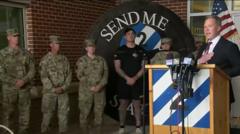How Did Soldiers Heroically Confront a Military Base Gunman?

Unarmed Soldiers' Heroism Prevents Tragedy at Fort Stewart Military Base
In a remarkable display of bravery, unarmed soldiers at Fort Stewart, Georgia, tackled and subdued a gunman who opened fire at the military base on Wednesday. This incident has been recognized as a significant act of heroism, preventing what could have been a far worse tragedy. Brigadier General John Lubas commended the quick actions of the US Army personnel, who "immediately raced [towards] and attacked" the suspect upon hearing gunfire. Their courage not only mitigated potential casualties but also highlighted the valor inherent in military service.
The shooter, identified as Quornelius Radford, a 28-year-old US Army sergeant, allegedly injured five individuals during the shooting spree. Fortunately, all victims are expected to recover, thanks in large part to the rapid response of their fellow soldiers who provided first aid and emotional support in the midst of chaos. The suspect is currently in custody, and authorities have stated they will not speculate on a motive as an investigation is underway.
Understanding the Incident
The incident unfolded around 11:00 AM local time at Fort Stewart, a sprawling military installation located approximately 240 miles southeast of Atlanta. Witnesses described the immediate aftermath of the gunfire, with soldiers rushing towards danger instead of retreating. Their instinct to protect their comrades was evident, as one non-commissioned officer bravely jumped on top of the assailant to restrain him until law enforcement arrived.
Army Secretary Dan Driscoll praised the soldiers' actions, stating, "Under duress and fire, they ran into battle to the sound of the gunfire." This acknowledgment underscores the importance of leadership and preparedness within military ranks, as soldiers are trained to respond decisively in crisis situations. The courage displayed by these individuals serves as a powerful reminder of the values instilled in military personnel.
The Aftermath of the Shooting
In the wake of the incident, six soldiers were honored with service medals for their bravery. Their actions not only saved lives but also demonstrated the unity and resilience of the military community. Staff Sgt. Melissa Taylor, one of the recipients, recounted her experience, stating that upon hearing gunfire, she immediately sprinted to assist a fellow soldier who was injured on the ground. Her quick response exemplifies the selflessness that characterizes many in the armed forces.
As of now, three of the five injured soldiers have been released from the hospital, while two remain in treatment. One of the more seriously injured individuals is reported to be in good spirits, while the other has a longer road ahead in their recovery process. The community continues to rally around the victims, offering support and encouragement during their healing journey.
Exploring the Suspect's Background
Quornelius Radford, the alleged shooter, was part of the 2nd Brigade Combat Team and had not been deployed to a combat zone prior to this incident. In a troubling revelation, it has come to light that he had a prior arrest for driving under the influence, which was known to military officials before the shooting occurred. This raises questions about the procedures in place for addressing behavioral issues among service members and the potential need for increased mental health support.
Radford's father spoke to the media, revealing that his son had sent a cryptic message to a family member before the shooting, expressing love for everyone and suggesting he was about to do something significant. This statement has led to speculation about Radford's mental state leading up to the event, but his father indicated that there had been no noticeable changes in behavior prior to the incident. The complexity of mental health issues within the military context cannot be overstated, and the Army is facing scrutiny regarding its approach to these challenges.
The Importance of Mental Health in the Military
The tragic events at Fort Stewart have sparked a renewed conversation about mental health support for soldiers. Mental health concerns are prevalent in military environments, and the stigma surrounding mental illness can often prevent service members from seeking help. Addressing these issues is crucial not only for the well-being of individuals but also for the safety of the entire community.
Military personnel face unique stressors, including the pressures of duty, potential exposure to trauma, and the challenges of reintegration into civilian life. It is essential for the military to foster an environment where soldiers feel safe to disclose their struggles and seek the necessary support. Some key strategies for improving mental health support within the military include:
- Increased Awareness: Conducting regular training and awareness programs about mental health issues can help reduce stigma.
- Accessible Resources: Ensuring that mental health resources are readily available and easy to access for all service members.
- Peer Support Programs: Implementing peer support systems where soldiers can talk to each other about their challenges.
- Trauma-Informed Care: Providing training for mental health professionals on trauma-informed care practices specific to military experiences.
Looking Ahead: The Role of Leadership
Leadership within the military plays a vital role in shaping the culture surrounding mental health. Leaders must prioritize mental well-being alongside physical readiness to create a more holistic approach to soldier care. As seen in the incident at Fort Stewart, effective leadership can inspire quick, life-saving actions, but it can also foster an environment where soldiers feel supported in their struggles.
The Army's ongoing investigation into the circumstances surrounding the shooting will likely include a thorough examination of Radford's background and mental health history. Findings from this investigation could lead to significant changes in policies and practices within the military, particularly regarding how mental health is addressed.
Conclusion: A Call to Action
The heroism displayed by the soldiers at Fort Stewart serves as a powerful reminder of the courage and commitment inherent in military service. Their actions not only prevented further injuries but also showcased the importance of unity and resilience within the armed forces. As the military grapples with the implications of this incident, it is essential for leaders and policymakers to prioritize mental health support to ensure the well-being of all service members.
In light of the recent events, we must collectively reflect on how we can support those who serve and protect us. Are we doing enough to address the mental health needs of our military personnel? Only through a concerted effort can we hope to prevent future tragedies and foster a culture of care and support within our armed forces.
Frequently Asked Questions
What led to the shooting at Fort Stewart?
The shooting was allegedly carried out by Quornelius Radford, a US Army sergeant, who opened fire at the military base, injuring five individuals. The investigation into the motive is ongoing.
How did soldiers respond to the gunman during the incident?
Unarmed soldiers immediately rushed towards the gunfire to subdue the suspect, demonstrating incredible bravery by tackling him and providing medical aid to the injured.
What are the current conditions of the injured soldiers?
Three of the five injured soldiers have been released from the hospital, while two continue to receive treatment. One of the more seriously injured individuals is reportedly in good spirits.
What steps are being taken to address mental health in the military?
There is a growing recognition of the need for enhanced mental health support in the military, including increased awareness, accessible resources, peer support programs, and trauma-informed care training.
As we reflect on the bravery shown at Fort Stewart, we must ask ourselves: How can we better support our military personnel in their times of need? #MilitaryHeroism #MentalHealthAwareness #FortStewart
Published: 2025-08-07 19:42:12 | Category: wales



